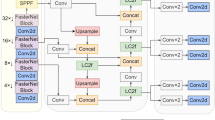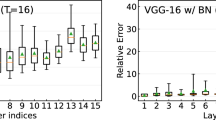Abstract
Backscatter communication networks have attracted much attention due to their small size and low power waste, but their spectrum resources are very limited and are often affected by link bursts. Channel prediction is a method to effectively utilize the spectrum resources and improve communication quality. Most channel prediction methods have failed to consider both spatial and frequency diversity. Meanwhile, there are still deficiencies in the existing channel detection methods in terms of overhead and hardware dependency. For the above reasons, we design a sequence-to-sequence channel prediction scheme. Our scheme is designed with three modules. The channel prediction module uses an encoder-decoder based deep learning model (EDChannel) to predict the sequence of channel indicator measurements. The channel detection module decides whether to perform a channel detection by a trigger that reflects the prediction effect. The channel selection module performs channel selection based on the channel coefficients of the prediction results. We use a commercial reader to collect data in a real environment, and build an EDChannel model based on the deep learning module of Tensorflow and Keras. As a result, we have implemented the channel prediction module and completed the overall channel selection process. The experimental results show that the EDChannel algorithm has higher prediction accuracy than the previous state-of-the-art methods. The overall throughput of our scheme is improved by approximately 2.9% and 14.1% over Zhao’s scheme in both stable and unstable environments.

















Similar content being viewed by others
References
Mitsugi, J., Kawakita, Y., Egawa, K., & Ichikawa, H. (2019). Perfectly synchronized streaming from multiple digitally modulated backscatter sensor tags. IEEE Journal of Radio Frequency Identification, 3(3), 149–156.
Ma, L., Hu, K., Zhu, Y., & Chen, H. (2014). Cooperative artificial bee colony algorithm for multi-objective rfid network planning. Journal of Network and Computer Applications, 42, 143–162.
Wang, Q., Zhao, J., Xu, S., & Wang, R. (2021). Retype: Your breath tells your mind! IEEE Internet of Things Journal, 8(11), 9436–9449.
Miao, Q., Xiao, F., Huang, H., Sun, L., & Wang, R. (2020). Smart attendance system based on frequency distribution algorithm with passive rfid tags. Tsinghua Science and Technology, 25(2), 217–226.
Zhao, J., Li, J., Li, D., & Yang, H. (2020). Optimal data transmission in backscatter communication for passive sensing systems. Tsinghua Science and Technology, 25(5), 647–658.
Zhao, J., Tian, H., & Li, D.-A. (2020). Channel prediction based on bp neural network for backscatter communication networks. Sensors, 20(1), 1125.
Gong, W., Chen, S., Liu, J., & Wang, Z. (2018) Mobirate: Mobility-aware rate adaptation using phy information for backscatter networks. In IEEE INFOCOM 2018-IEEE conference on computer communications (pp. 1259–1267).
Zhang, J., Smith, D., & Chen, Z. (2012). Linear finite state Markov chain predictor for channel prediction. In IEEE 23rd international symposium on personal. Indoor and mobile radio communications-(PIMRC) (pp. 2085–2089).
Zhao, W., Wang, G., Atapattu, S., & Ai, B. (2018). Blind channel estimation in ambient backscatter communication systems with multiple-antenna reader. In IEEE/CIC international conference on communications in China (ICCC) (pp. 320–324).
Ma, S., Zhu, Y., Wang, G., & He, R. (2018). Machine learning aided channel estimation for ambient backscatter communication systems. In IEEE international conference on communication systems (ICCS) (pp. 67–71).
Ma, S., Wang, G., Fan, R., & Tellambura, C. (2018). Blind channel estimation for ambient backscatter communication systems. IEEE Communications Letters, 22(6), 1296–1299.
Lv, Y., Peng, S., Yuan, Y., Wang, C., Yin, P., Liu, J., & Wang, C. (2019). A classifier using online bagging ensemble method for big data stream learning. Tsinghua Science and Technology, 24(4), 379–388.
Ma, L., Cheng, S., & Shi, Y. (2021). Enhancing learning efficiency of brain storm optimization via orthogonal learning design. IEEE Transactions on Systems, Man, and Cybernetics: Systems, 51(11), 6723–6742.
Son, W.-S., & Han, D. S. (2021). Analysis on the channel prediction accuracy of deep learning-based approach. In International conference on artificial intelligence in information and communication (ICAIIC) (pp. 140–143).
Cho, K., van Merriënboer, B., Gulcehre, C., Bahdanau, D., Bougares, F., Schwenk, H., & Bengio, Y. (2014). Learning phrase representations using RNN encoder–decoder for statistical machine translation. In Proceedings of the 2014 conference on empirical methods in natural language processing (EMNLP). Doha, Qatar: Association for Computational Linguistics (pp. 1724–1734). https://aclanthology.org/D14-1179
Kulkarni, A., Seetharam, A., Ramesh, A., & Herath, J. D. (2020). Deepchannel: Wireless channel quality prediction using deep learning. IEEE Transactions on Vehicular Technology, 69(1), 443–456.
Yuan, L., Guo, T., He, Y., & Cheng, Z. (2018). The application of Markov model optimization method in wireless channel modeling. In 2018 10th international conference on communications, circuits and systems (ICCCAS). IEEE (pp. 315–319).
Liu, Z., Del Rosario, M., & Ding, Z. (2021). A Markovian model-driven deep learning framework for massive mimo csi feedback. IEEE Transactions on Wireless Communications., 2, 4478.
Wang, H. S., & Chang, P.-C. (1996). On verifying the first-order Markovian assumption for a Rayleigh fading channel model. IEEE Transactions on Vehicular Technology, 45(2), 353–357.
Chen, C., Wang, G., Gao, F., Eldar, Y. C., & Guan, H. (2018). Blind detection for ambient backscatter communication system with multiple-antenna tags. In IEEE global communications conference (GLOBECOM) (pp. 206–212).
Hou, Y., Kawasaki, S., & Denno, S. (2021). Busy/idle duration prediction for video and audio wlan traffics using autoregressive predictor with data categorization. In 2021 23rd international conference on advanced communication technology (ICACT). IEEE (pp. 259–264).
Wu, D., & Zhang, J. (2021). Time-domain data analysis of Maglev system emi based on arima model. In 2021 IEEE conference on telecommunications, optics and computer science (TOCS). IEEE (pp. 72–75).
Shadroo, S., Rahmani, A. M., & Rezaee, A. (2022). Survey on the application of deep learning in the Internet of Things. Telecommunication Systems, 3, 1–27.
Ngo, T., Kelley, B., & Rad, P. (2021). Deep learning based prediction of channel profile for lte and 5G systems. In European wireless 2021; 26th European wireless conference. VDE (pp. 1–7).
Kim, S.-C., & Kim, Y.-H. (2022). Efficient classification of human activity using pca and deep learning lstm with wifi csi. In International conference on artificial intelligence in information and communication (ICAIIC) (pp. 329–332).
Qi, C., Wang, Y., & Li, G. Y. (2020). Deep learning for beam training in millimeter wave massive mimo systems. IEEE Transactions on Wireless Communications, PP(99), 1–1.
Shehzad, M. K., Rose, L., Wesemann, S., & Assaad, M. (2022). Ml-based massive mimo channel prediction: Does it work on real-world data? IEEE Wireless Communications Letters, 69(1), 518–528.
Son, W.-S., & Han, D. S. (2021). Analysis on the channel prediction accuracy of deep learning-based approach. In 2021 international conference on artificial intelligence in information and communication (ICAIIC). IEEE (pp. 140–143).
Gong, W., Liu, H., Liu, K., Ma, Q., & Liu, Y. (2016). Exploiting channel diversity for rate adaptation in backscatter communication networks. In IEEE INFOCOM 2016-the 35th annual IEEE international conference on computer communications (pp. 1–9).
Zhang, P., Gummeson, J., Ganesan, D. (2012). Blink: A high throughput link layer for backscatter communication. In Proceedings of the 10th international conference on mobile systems, applications, and services (pp. 99–112), ser. MobiSys ’12. New York, NY, USA: Association for Computing Machinery. https://doi.org/10.1145/2307636.2307646
Park, S. H., Kim, B., Kang, C. M., Chung, C. C., & Choi, J. W. (2018). Sequence-to-sequence prediction of vehicle trajectory via lstm encoder-decoder architecture. In IEEE intelligent vehicles symposium (IV) (pp. 1672–1678).
Thapa, K. N. K., & Duraipandian, N. (2021). Malicious traffic classification using long short-term memory (lstm) model. Wireless Personal Communications, 119(3), 2707–2724.
Koushik, C., & Vetrivelan, P. (2020). Heuristic relay-node selection in opportunistic network using rnn-lstm based mobility prediction. Wireless Personal Communications, 114(3), 2363–2388.
Li, S., Wang, Q., Liu, X., & Chen, J. (2018). Low cost lstm implementation based on Stochastic computing for channel state information prediction. In IEEE Asia Pacific conference on circuits and systems (APCCAS) (pp. 231–234).
Trigeorgis, G., Ringeval, F., Brueckner, R., Marchi, E., Nicolaou, M.A., Schuller, B., & Zafeiriou, S. (2016). Adieu features? End-to-end speech emotion recognition using a deep convolutional recurrent network. In 2016 IEEE international conference on acoustics, speech and signal processing (ICASSP) (pp. 5200–5204).
Funding
This paper supported by The General Object of National Natural Science Foundation under Grants(61972273); National Major Scientific Research Instrument Development Project (6202780085); National Natural Science Foundation of China(62102280); Fundamental Research Program of Shanxi Province(20210302124167); National Key R &D Project(2018YFB2200900); Shanxi Province key technology and generic technology R &D project(2020XXX007).
Author information
Authors and Affiliations
Corresponding author
Ethics declarations
Conflict of interest
All authors have declare that they have no conflict of interest.
Consent for publication
Yes
Additional information
Publisher's Note
Springer Nature remains neutral with regard to jurisdictional claims in published maps and institutional affiliations.
Rights and permissions
About this article
Cite this article
Li, D., Wen, Y., Xu, S. et al. EDChannel: channel prediction of backscatter communication network based on encoder-decoder. Telecommun Syst 81, 99–114 (2022). https://doi.org/10.1007/s11235-022-00929-8
Accepted:
Published:
Issue Date:
DOI: https://doi.org/10.1007/s11235-022-00929-8




